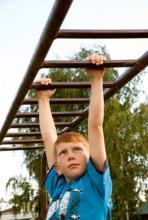
Eye-hand coordination is the ability of the vision system to coordinate the movement of the hands to perform a task. While vision is the process of understanding what the eye sees, it also involves the ability to move the eyes in a particular direction to aim and focus on an object. The effectual use of the hands to perform an activity usually requires visual input.1
The development of hand skills is influenced by cognition, vision, touch, and movement. While hand movements are influenced by the senses of sight and touch, there is a progression of “learned” skills that relate to a child’s cognitive development as he ages.2
At birth a baby cannot see farther than about eight inches from his face until he is two months old, and his hand movements are spontaneous to the touch. At three to four months old most infants can begin to grab and hold objects, and by six months they can visually locate an object, reach for it, and play with it in their hands. The ability to transfer the ball from one hand to the other at twelve months of age begins the development of more complex two-handed skills. As toddlers are able to grasp objects between the thumb and forefinger (pincer grasp), they can begin gathering, stacking, and nesting objects as they play with toys and blocks. These skills improve with repetition of the activities.3
Between three and five years of age, children show a preference for left or right handedness and also develop their ability to run, jump, climb, balance, push, and pull with better depth perception and eye-hand coordination. Children between five and seven years of age improve on these skills and further develop fine motor skills, such as using scissors and handling writing instruments.4
Children’s eye-hand coordination skills improve as they play with toys, blocks, puzzles, and balls. As children get older, games, such as dodgeball, baseball, and volleyball, require focus and manual dexterity.5 Playing catch, bouncing a ball off a wall, and playing a game of ping pong can improve eye-hand coordination with practice.
On the playground eye-hand coordination is required to navigate the various elements of the playground equipment. Climbing on monkey bars and brachiating on overhead ladders and rings require manual dexterity and visual perception to be able to judge the distance from one rung to the next and be able to coordinate the physical movements to reach the next rung.6
Developmental delays of children in eye-hand coordination are usually first noted in poor drawing or writing skills. Their lack of interest in toys that require fine motor skills, such as building blocks and tinker toys, and their preference for active activities is also an indication of a problem.7
Poor eye-hand coordination can have a variety of causes, but there are two main conditions responsible: vision problems and movement disorders. Impaired vision can distort and limit the information needed to process visual cues with hand movement. Impaired body movements can have a variety of causes. A lack of coordination while performing voluntary movements may appear as clumsiness, with jerky, disjointed movements. Movement disorders impede the development of normal eye-hand coordination.8
- 1. Laberg, Monique. “Hand-eye Coordination.” Encyclopedia of Children’s Health. < http://www.healthofchildren.com/G-H/Hand-Eye-Coordination.html > 4 Aug. 2010.
- 2. “Eye-Hand Coordination.” Richie McFarland Children’s Center. < http://www.richiemcfarland.org/index_files/Page1793.htm > 4 Aug. 2010.
- 3. Ibid.
- 4. Op. cit., Laberg, Monique.
- 5. Robin, Craig. “How to Improve Eye-Hand Coordination in Children by Playing Specific Games Designed For Children.” Ezinearticles.com. < http://ezinearticles.com/?How-to-Improve-Eye-Hand-Coordination-in-Children-by-Playing-Specific-Games-Designed-For-Children&id=2025688 > 4 Aug. 2010.
- 6. Frost, Joe L., Pei-San Brown, John A. Sutterby, Candra D. Thornton. The Developmental Benefits of Playgrounds. Olney, MD: Association for Childhood Education International, 2004. p. 93.
- 7. “Eye-Hand Coordination” The Teacher Spot.com. < http://www.theteacherspot.com/firstyears/eye_hand_coordination.html > 4 Aug. 2010.
- 8. Op. cit., Laberg, Monique.

